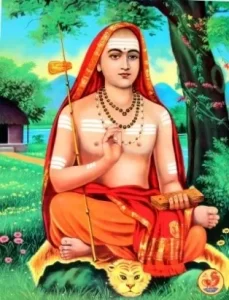Adi Sankara
- Home
- Adi Sankara

Adi Shankara or Shankaracharya was born when Hinduism as a religion was in utter chaos. The multiplicity of religious practices saw the rise of many cults all claiming to be the real Hinduism. The real Hinduism or the Sanatan Dharma was passing through a difficult phase. With vedic tradition under attack, it was Shankaracharya’s genius that reinvented Hinduism and re-established the vedic tradition with his excellent commentaries on Brahamasutras, Upanishads and the Bhagavad Gita.
It was his period that saw the re-emergence of Hinduism. The basic contribution of Shankaracharya was his brilliant explanation of the Indian philosophical thought and his concept of advait or non-dualism that tends to give a unique position to Hinduism among a pantheon of religions.
Shankaracharya’s philosophy is a complete philosophy that gives a holistic explanation of Hinduism. According to him, the ultimate reality is Brahman or pure consciousness, the consciousness of the pure self that is devoid of all attributes and all categories of the intellect. The common understanding of the concept of Maya as given by Shankara is that the world is an illusion and this makes the understanding of his philosophy difficult. The world for all practical purposes is real, then how can it be an illusion?
But the essence of Shankara philosophy is that from the phenomenal point of view the world is quite real. It is not an illusion but a practical reality. He uses an analogy of dream to explain this. Just as things seen in a dreaming state appear to be quite true for the dreamer who partakes in that, so also is this illusory nature of the world. Only after waking does one realise that it was an illusion.
Thus it is the ignorance or avidya in Shankaracharya’s terms that makes this illusory world of Maya appear real and we get involved. Maya thus is not only absence of knowledge, it is also positive wrong knowledge. This nature of Maya renders it indescribable as it is both real and unreal. Parallels can be drawn with the concept of perception in experimental psychology. The real world is not the perceived world. Rather it is the perceived world that appears to be the real world.
Thus, the concept of Maya in Shankaracharaya’s philosophy is also mentioned asbhram or bhranti, a result of error of perception. This is beautifully explained with the help of the snake and the rope illusion. If we see a snake and believe that it is a rope we act as if we see a rope. On the other hand, if we see a rope and perceive it as a snake we behave as if we have seen a snake. Illusions are real as long as the error in perception is not realised.
Apparently Shankaracharya’s philosophy is supposed to be an antithesis of Buddhism. But if we go deep we find that the influence of Mahayana Buddhism is there is Shankaracharya’s philosophy. Though understanding Shankaracharya’s philosophy requires a thorough understanding of the Vedanta, yet the crux of his theory lies in the statement that brahman is the only reality, the world is ultimately an illusion. But this realisation can only dawn when ignorance or avidya that arises from the ego vanishes. As once again Hinduism is being defined and redefined, it is time to go back to Shankaracharya’s philosophy that is perhaps the best description of this great religion.
